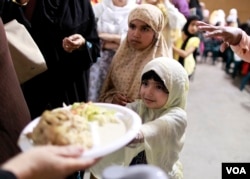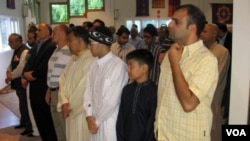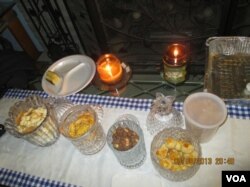Mirrah is starting a master's degree in bioengineering this fall at the University of Pittsburgh in Pennsylvania. But before she begins her studies, she had to conquer another challenge - her first Ramadan and Eid-al Fitr in the U.S. She wrote to us to "share my story about how I fasted and how I celebrated."
And how did she enjoy celebrating outside her home country? Let's go ahead and ruin the suspense. "I can tell you that my Ramadan and Eid this year, it rocked!" Here's why:
As a Muslim, I am obliged to fast during the Ramadan month. From Fajr, which is before sunrise, until sunset each day, I cannot eat or drink and I have to control my emotions as well. It was an extraordinary 30 days of fasting that I had this year.
I was fasting outside Indonesia, observing Ramadan in the United States for the first time.
In my home country, Muslims make up almost two-third of the population. It is easier to fast because most people are doing it too. Most restaurants cover their windows during the day and people do not eat in a public or common space. But, here, no-no! When lunch break comes, there are people who will eat their sumptuous peanut butter and jelly sandwiches in front of you, and it is not them who are supposed to be tolerant, but you!
They won’t know that you are fasting, so if you think that the food may intimidate you (or let’s say, be too mouth-watering for you), you have to go somewhere else. Or you may find yourself in a situation where all your friends choose to hang out at a coffee shop, and you are only able to stare at everyone’s drinks – unless the meeting is after sunset.
Secondly, Ramadan this year happened in the summer, and in the U.S., summer days are very long. Back in Indonesia, I usually fasted from 4 am until 6 pm. But here in the U.S., I spent most of the Ramadan month by fasting from around 3:30 am until 8:30 pm. My friends who live in the U.S. were like “What?!” when I told them I could not eat or drink anything for nearly 17 hours.
At first the fasting was just so hard for me. I was okay in the morning, but by four or five o’clock in the afternoon, I just wanted to lie on my bed, waiting until the sun went down. Luckily, my Muslim friend supported me and said, “Come on Mirrah! It is only the initial part that is hard. Within three or four days, our body will adjust to this eating habit and we will be just fine!” And yes, he was right.
As days passed, the end of Ramadan came. This year, the end of Ramadan was on the 7th of August. On the next day, Muslims celebrate Eid-al Fitr, a happy and blissful day marking that the Ramadan month is over and the new Islamic month has come (Syawal month). In the morning of Eid-al Fitr, all Muslims go to the nearest mosque, Islamic center, or an open field. We gather and do the Eid-al Fitr prayer and listen to the khutbah (a term for Islamic preaching).
I am so grateful that here in Pittsburgh the Muslim community is quite big. It is so wonderful to see the Muslims from various countries, with their cultural varieties, gather in the Islamic Center of Pittsburgh for Eid. I really enjoyed seeing what they wore on that special day. Beautiful veils, colorful clothes and scarves - all those people looked nice!
After the praying, Muslims who still had to work went to their work places. This is also something that differentiates the U.S. and my home country. In Indonesia, Eid-al Fitr is a public holiday, and after they pray, people will go to visit their relatives or just spend that joyful day with their family at home. In the U.S., Muslims often still have to work their 9 to 5 schedule on Eid-al Fitr.
But soon after they get back from work, some Muslims in the U.S. do an “open-house.” That means they open their house for friends and relatives to come and have a feast. There is plenty of foods and sweets, although the types of dishes vary from one culture to another.
I went to an open-house that was held by an Indonesian family. They served authentic Indonesian foods that I was used to seeing during Eid in my home country – chicken opor, beef semur, fried potato sambal, rice lontong, and the all-time favorite, a pineapple jam cookie called nastar. Those delicacies cured my longing for my mother’s cooking!
I went back to my place with a very full stomach. And with a little bit of worry about how to get rid of the excessive calories – but oh well, today’s happiness knocked down that feeling!
In the end, I just want to say to all my Muslim friends that having a Ramadan month and Eid-al Fitr in the U.S. is truly an exciting experience. Like I said, it rocked! :-)
How have you had to adapt your customs and holidays in the U.S.? Have you found it as exciting as Mirrah has? Share your story in the comments or using the form below.
And how did she enjoy celebrating outside her home country? Let's go ahead and ruin the suspense. "I can tell you that my Ramadan and Eid this year, it rocked!" Here's why:
As a Muslim, I am obliged to fast during the Ramadan month. From Fajr, which is before sunrise, until sunset each day, I cannot eat or drink and I have to control my emotions as well. It was an extraordinary 30 days of fasting that I had this year.
I was fasting outside Indonesia, observing Ramadan in the United States for the first time.
In my home country, Muslims make up almost two-third of the population. It is easier to fast because most people are doing it too. Most restaurants cover their windows during the day and people do not eat in a public or common space. But, here, no-no! When lunch break comes, there are people who will eat their sumptuous peanut butter and jelly sandwiches in front of you, and it is not them who are supposed to be tolerant, but you!
They won’t know that you are fasting, so if you think that the food may intimidate you (or let’s say, be too mouth-watering for you), you have to go somewhere else. Or you may find yourself in a situation where all your friends choose to hang out at a coffee shop, and you are only able to stare at everyone’s drinks – unless the meeting is after sunset.
Secondly, Ramadan this year happened in the summer, and in the U.S., summer days are very long. Back in Indonesia, I usually fasted from 4 am until 6 pm. But here in the U.S., I spent most of the Ramadan month by fasting from around 3:30 am until 8:30 pm. My friends who live in the U.S. were like “What?!” when I told them I could not eat or drink anything for nearly 17 hours.
At first the fasting was just so hard for me. I was okay in the morning, but by four or five o’clock in the afternoon, I just wanted to lie on my bed, waiting until the sun went down. Luckily, my Muslim friend supported me and said, “Come on Mirrah! It is only the initial part that is hard. Within three or four days, our body will adjust to this eating habit and we will be just fine!” And yes, he was right.
As days passed, the end of Ramadan came. This year, the end of Ramadan was on the 7th of August. On the next day, Muslims celebrate Eid-al Fitr, a happy and blissful day marking that the Ramadan month is over and the new Islamic month has come (Syawal month). In the morning of Eid-al Fitr, all Muslims go to the nearest mosque, Islamic center, or an open field. We gather and do the Eid-al Fitr prayer and listen to the khutbah (a term for Islamic preaching).
I am so grateful that here in Pittsburgh the Muslim community is quite big. It is so wonderful to see the Muslims from various countries, with their cultural varieties, gather in the Islamic Center of Pittsburgh for Eid. I really enjoyed seeing what they wore on that special day. Beautiful veils, colorful clothes and scarves - all those people looked nice!
After the praying, Muslims who still had to work went to their work places. This is also something that differentiates the U.S. and my home country. In Indonesia, Eid-al Fitr is a public holiday, and after they pray, people will go to visit their relatives or just spend that joyful day with their family at home. In the U.S., Muslims often still have to work their 9 to 5 schedule on Eid-al Fitr.
But soon after they get back from work, some Muslims in the U.S. do an “open-house.” That means they open their house for friends and relatives to come and have a feast. There is plenty of foods and sweets, although the types of dishes vary from one culture to another.
I went to an open-house that was held by an Indonesian family. They served authentic Indonesian foods that I was used to seeing during Eid in my home country – chicken opor, beef semur, fried potato sambal, rice lontong, and the all-time favorite, a pineapple jam cookie called nastar. Those delicacies cured my longing for my mother’s cooking!
I went back to my place with a very full stomach. And with a little bit of worry about how to get rid of the excessive calories – but oh well, today’s happiness knocked down that feeling!
In the end, I just want to say to all my Muslim friends that having a Ramadan month and Eid-al Fitr in the U.S. is truly an exciting experience. Like I said, it rocked! :-)
How have you had to adapt your customs and holidays in the U.S.? Have you found it as exciting as Mirrah has? Share your story in the comments or using the form below.








